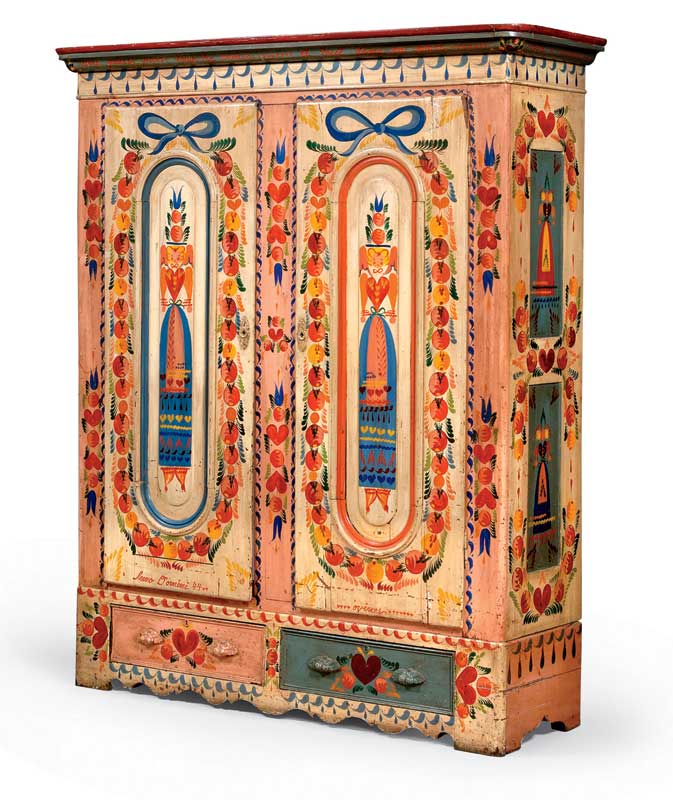Antiques: Folk Artist Peter Hunt
Lately I’ve taken to wearing a curious adornment: my husband’s high-school ID bracelet, given to him by an apple-cheeked girlfriend more than 30 years ago. Clunky and ill-fitting, it’s etched with the name MIKE and inscribed on the reverse LOVE, MURIEL. For all its adolescent awkwardness, I love the look and feel of it. “Why […]

Coffee By Design | Portland, Maine
Photo Credit : Katherine KeenanLately I’ve taken to wearing a curious adornment: my husband’s high-school ID bracelet, given to him by an apple-cheeked girlfriend more than 30 years ago. Clunky and ill-fitting, it’s etched with the name MIKE and inscribed on the reverse LOVE, MURIEL. For all its adolescent awkwardness, I love the look and feel of it. “Why are you wearing that?” my husband chuckles.
I reply that I’m drawn to its unbridled sweetness. It conjures up my own memory of a boy who kissed me atop the Ferris wheel at Canobie Lake Park one summer night. “Let’s face it,” I say, “I’m a sucker for charming.”
I’m not alone. Charm can be intoxicating, even infectious. That was the secret behind the success of Peter Hunt, the legendary 20th-century folk artist who took all of New England and New York by storm with his charming cottage-style furniture and collectibles.
Hunt was born Frederick Lowe Schnitzler, the son of poor immigrants, in 1896 and raised in Jersey City, New Jersey. During World War I, the family changed its name to Hunt. As a young adult, Frederick reinvented himself through fable and fantasy and became Peter Hunt, bohemian artist of Greenwich Village and Boston. In the 1920s, he moved to Provincetown, Massachusetts, and set up a shop and later a studio. He painted old furniture, household items, and fabrics, decorating them with colorful peasant designs, reminiscent of Pennsylvania German and French Provincial folk art. Hearts, flowers, fruits, birds, angels, and pretty maidens and their suitors adorned hutches, cabinets, dressers, tables, chairs, stools, wooden trays, fabrics, tins, and metalware. Hunt further embellished some of those pieces with pseudo-French phrases scrawled across their surfaces.
With his artistic talent, good looks, charm, wit, and knack for outrageous storytelling, Hunt wooed and delighted wealthy matrons and high-society tastemakers vacationing on Cape Cod. They found him irresistible, and his cheerful designs the perfect look for their summer cottages. Hunt’s clients were rich and influential; among them were Boston socialite Frances Brown Merkel and New York cosmetics diva Helena Rubinstein, both of whom helped advance Peter Hunt’s name and reputation.
By the 1930s, his single storefront in Provincetown had become a series of shops aptly named Peter Hunt’s Peasant Village. He employed young artists to decorate pieces in his signature style, and upscale New York department stores began carrying his furniture and knickknacks. Throughout the 1930s and ’40s, Hunt’s star shone brightly: He was asked to design the famous “Cape Cod Room” restaurant at Chicago’s Drake Hotel; he published a series of decorator books; and he was profiled in the pages of Life, House Beautiful, and Mademoiselle magazines.
By the 1950s, the public’s interest in peasant style had begun to wane, so Hunt sold his Peasant Village and moved to the town of Orleans on Cape Cod; there he opened an eclectic shop named Peacock Alley, which witnessed limited success. Hunt’s life ended in near obscurity; he died almost penniless in 1967.
For many years, Peter Hunt designs littered attics and yard sales, but recently, the popularity of his creations has resurged. LaGina Austin, American folk art specialist at Skinner Auctioneers & Appraisers, describes Peter Hunt furniture and collectibles as ranging from “folksy and attractive to kitschy, almost corny”–but devotees eat them up, paying $200 to several thousand per piece at auction. Austin’s advice to buyers: “Look for elaborately decorated examples, with great color and little wear to the painted surface.”
Ask any collector to explain the lasting appeal of Peter Hunt, and you’ll get but one answer: “The stuff is charming.” I can’t argue with that.







